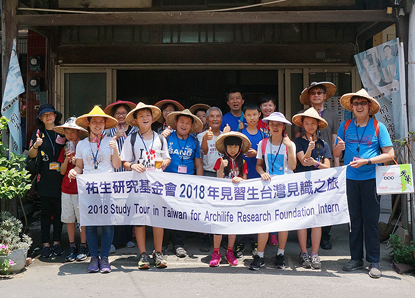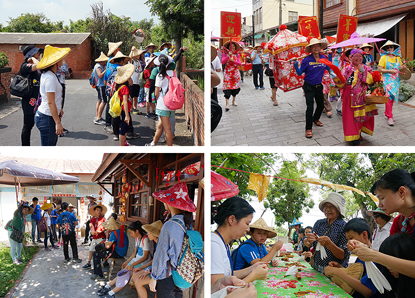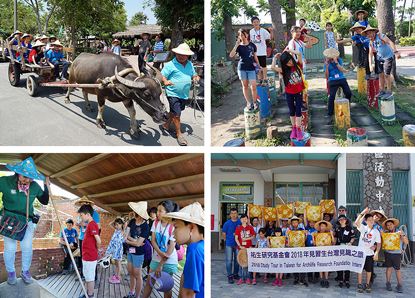Sketch of Archilife Study Tour, May 2018
|
2018年5月份見識之旅縮影  5月份見識之旅活動,於2018年5月19日由呂明澐小姐帶領14位祐生見習生及家長們,進行台南菁寮無米樂農村探索之旅。活動開始之初,領隊呂明澐小姐提醒本次活動注意事項及觀察重點,先行建立見習生的背景知識。 5月份見識之旅活動,於2018年5月19日由呂明澐小姐帶領14位祐生見習生及家長們,進行台南菁寮無米樂農村探索之旅。活動開始之初,領隊呂明澐小姐提醒本次活動注意事項及觀察重點,先行建立見習生的背景知識。For the study tour of May 19, 2018, Ms. Lu Ming-yun led 14 ARF interns and their parents on a discovery trip to Wumile Rural Community in Jingliao, Tainan. At the start of the day's activities, team leader Ms. Lu Ming-yun reminded everyone about things to note and what to observe, and provided the interns some general background knowledge.  本次行程以台南菁寮社區為參訪主軸,由在地居民擔任導覽人員。菁寮係清領時期南北交通的中心,然因時代變遷,逐漸沒落,卻保留樸實的農村文化,紀錄片「無米樂」即在此拍攝。行程之初,導覽人員講述「無米樂」命名的由來,帶出當地老農知足常樂的生活態度,接著走訪農村風光,說明早期因物資匱乏,居家環境又須造景美化才賞心悅目,故每戶人家會種植瓜果或蔬菜代替花草,兼具觀賞性與食用價值,至今仍可見得各式果樹。隨即來到菁寮老街,導覽人員介紹老街昔日為嫁妝一條街,從男女相親約會的古早冰店到訂製嫁妝的棉被店一應俱全,眾人亦實際入內參訪,並於街道上見識早期農業社會嫁娶「嫁妝一牛車」的隆重排場。隨後進行洋蔥染DIY,大家在了解基本構圖要訣後,透過橡皮筋、冰棒棍等工具,於方布巾上創作,完成後成就感十足。 本次行程以台南菁寮社區為參訪主軸,由在地居民擔任導覽人員。菁寮係清領時期南北交通的中心,然因時代變遷,逐漸沒落,卻保留樸實的農村文化,紀錄片「無米樂」即在此拍攝。行程之初,導覽人員講述「無米樂」命名的由來,帶出當地老農知足常樂的生活態度,接著走訪農村風光,說明早期因物資匱乏,居家環境又須造景美化才賞心悅目,故每戶人家會種植瓜果或蔬菜代替花草,兼具觀賞性與食用價值,至今仍可見得各式果樹。隨即來到菁寮老街,導覽人員介紹老街昔日為嫁妝一條街,從男女相親約會的古早冰店到訂製嫁妝的棉被店一應俱全,眾人亦實際入內參訪,並於街道上見識早期農業社會嫁娶「嫁妝一牛車」的隆重排場。隨後進行洋蔥染DIY,大家在了解基本構圖要訣後,透過橡皮筋、冰棒棍等工具,於方布巾上創作,完成後成就感十足。The focus of the tour was the Jingliao community in Tainan and the tour was guided by local residents. Jingliao was the center connecting the north and south during the Qing Dynasty. Despite its decline due to changes over time, its rustic agricultural village culture have remained. In fact, the documentary "Let It Be" was filmed in Jingliao. The study tour began with an explanation of the origin of the name "Wumile", translated as "let it be", which is an allusion to the optimistic attitude of local old farmers toward life. During the tour of the rural community, the tour guide explained that, in the early days when resources are scarce, every household would grow fruits and vegetables in place of flowers for their values as decorative ornaments for the living environment as well as food for the family. A wide variety of fruit trees can still be seen in the community today. Upon arriving at Jingliao Old Street, the tour guide said that the street used to be the place to shop for wedding supplies. There was an old-fashion ice-cream shop where young men and women met on blind dates, and a shop where the bridal bedding sets could be customized. Everyone visited the shops and even saw the elaborate setting for weddings in early agricultural society where bridal dowry was loaded on an ox cart. In the DIY activity that followed, onion skins were used as dye. After learning the basic techniques and patterns, rubber bands and ice-cream sticks were used as tools for dyeing square pieces of cloth, and the interns felt a great sense of accomplishment upon seeing their creations.  中午飯後,眾人搭乘牛車進行社區巡禮,感受有別於都市的田間風光與熱情。緊接著至滾藺草體驗區,導覽人員首先說明該地區早期多以藺草編織為副業,待藺草收割經太陽曝曬後,以腳踩動石鼓的方式將草莖輾平,利於後續編織工作。隨後見習生們踏上石鼓,體驗昔日婦女的辛勞。接著前往聖十字教堂,由法國籍神父以流利的台語導覽,解釋教堂設立的原由,並教導眾人心誠則靈的重要。行程最後來到菁寮國小,導覽人員介紹該校始建於日治時期,學生就讀人數最多曾達二千人,卻因產業沒落導致人口外流嚴重,目前不足百位,感嘆之餘,亦促使眾人思考相關議題的改善方案。至此,本日活動已近尾聲,大家一起合照留念後搭車返程,並期待於下次見識之旅再相見。 中午飯後,眾人搭乘牛車進行社區巡禮,感受有別於都市的田間風光與熱情。緊接著至滾藺草體驗區,導覽人員首先說明該地區早期多以藺草編織為副業,待藺草收割經太陽曝曬後,以腳踩動石鼓的方式將草莖輾平,利於後續編織工作。隨後見習生們踏上石鼓,體驗昔日婦女的辛勞。接著前往聖十字教堂,由法國籍神父以流利的台語導覽,解釋教堂設立的原由,並教導眾人心誠則靈的重要。行程最後來到菁寮國小,導覽人員介紹該校始建於日治時期,學生就讀人數最多曾達二千人,卻因產業沒落導致人口外流嚴重,目前不足百位,感嘆之餘,亦促使眾人思考相關議題的改善方案。至此,本日活動已近尾聲,大家一起合照留念後搭車返程,並期待於下次見識之旅再相見。After lunch, everyone toured the community riding an ox cart, and experienced the rural scenery and friendliness which were different from the city. At the experiential area for rolling rush grass, the tour guide began by explaining that rush-grass weaving was mainly a part-time job in the early days. The rush grass were harvested and sun-dried, and flattened using a stone drum operated by foot. The interns tried stepping on the stone to experience the hardship of women who had to roll the rush grass in the past. The next stop of the tour was the Jingliao Catholic Church. The tour was guided by a French priest who spoke fluent Taiwanese. He explained the reason for the church's establishment and taught everyone the importance of having faith. The final destination of the tour was Jingliao Elementary School. Introducing the school, the tour guide said that it was built during the Japanese Occupation. It once had 2,000 students but there are now less than a hundred students due to severe population loss caused by industry decline. It also prompted everyone to think about solutions to the issue. At this point, the day's itinerary came to an end. Everyone took a group photo before heading back and looked forward to the next study tour. |

